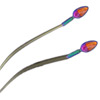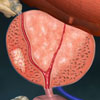- What is the male urogenital system?
- Testes
- Epididymis
- Vas deferens
- Ejaculatory ducts
- Urethra
- Penis
- Prostate gland
- Accessory glands
What is the male urogenital system?
The term urogenital refers to something that has both urinary and genital origins. The word urogenital is used because the urinary and reproductive systems in males merge. The male urogenital system consists of several parts, including the testes, epididymis, vas deferens, ejaculatory ducts, urethra, penis, prostate and accessory glands.

Testes
The testis is a firm, mobile organ lying within the scrotum; the left testis lies slightly lower than the right. The testes are the primary reproductive organs (gonads) in the male, and are responsible for the production of sperm. The testis is covered by a capsule. The inner surface of the testicular capsule has projections that divide the organ into lobules. Contained within these lobules are the seminiferous tubules, which open into a series of channels called the rete testis. Sperm moves from the rete testis to the upper epididymis via the efferent ductules.
One of the main functional components of the testes are the seminiferous tubules. Other important functional components of the testis are Sertoli cells and Leydig cells.
The Leydig cells in the testis are responsible for the production of testosterone, and are almost nonexistent before puberty. The testosterone secreted by these cells is responsible for the development of secondary sexual characteristics, including:
- Changes to body hair distribution
- Baldness (testosterone decreases hair follicle growth on the top of the head)
- Change in voice
- Increased skin thickness and development of acne
- Increased bone density
- Increased basal metabolic levels
- Increased number of red blood cells
- Increased body water due to increased resorption of water and electrolytes in the kidneys
Formation of sperm

The developing sperm undergo a series of divisions during development (meiosis). The first division takes approximately 24 days to complete. The second division occurs within 2–3 days of the first. The end result is four daughter cells, each with half the genetic material that they started off with. The importance of this is that when the sperm unites with the ovum, half the genes in the fertilised egg are from the father and half from the mother.
The development of sperm continues after division. The action of Sertoli cells causes cell remodelling, eventually converting the developing sperm into a spermatozoan.
Points to note:
- The temperature of the testes effects spermatogenesis (sperm formation). The scrotum (the skin covered sac that holds the testicles) functions as a sensitive regulator of temperature; by contracting and relaxing, it modifies testicular temperature. The optimal temperature for the testes is approximately 2 degrees below body temperature (i.e. about 35oC).
- Sperm count can effect the fertility of males. The normal range for a sperm count is 35–200 million sperm per ejaculate. A male is defined as being infertile if he has a sperm count below 20 million.
- Male fertility is also affected by the morphology (shape and size) of the sperm in the ejaculate. Abnormal morphology can render the sperm ineffective, thus causing infertility even if the sperm count is normal.
 |
For more information on sperm health, including factors affecting sperm health and investigations of sperm health, see Sperm Health. |
Epididymis
The epididymis is a firm structure that consists of three parts: the expanded head, the body, and the tail. The epididymis is a coiled tube covered by connective tissue. Fully expanded, it is approximately 20 m long. At the tail of the epididymis, a tube called the vas deferens emerges.
Sperm pass into the epididymis after they are formed in the seminiferous tubules. The sperm in the seminiferous tubules and early epididymis cannot move. These non-motile sperm gain the potential to move after 18–24 hours in the epididymis, though the production of specific substances within the epididymis prevents actual movement.
Vas deferens
The vas deferens is a 45 cm long muscular tube that transports sperm to the ejaculatory ducts.
Ejaculatory ducts
The two ejaculatory ducts are formed by the union of the vas deferens with the ducts arising from the seminal vesicles (accessory glands that secrete fluid) on either side. They are approximately 2 cm long, piercing the prostate gland and emptying into the part of the urethra that runs through the prostate.
Urethra
The male urethra is approximately 18–20 cm long; it extends from the internal orifice of the urinary bladder to the external opening at the end of the penis.
The urethra allows the passage of both urine and sperm.
Penis

There are two main parts of the penis:
- Root: There are three main parts of the root of the penis: the midline bulb, and the left and right crura on either side of the bulb.
- Body: The body of the penis consists of three cylindrical masses of erectile tissue: the corpus spongiosum in the midline, and the two corpus cavernosa on either side. At the end of the corpus spongiosum is the head of the penis, where the urethra opens.
Erection
Erection occurs due to nervous impulses as a result of sexual arousal. The erectile tissue becomes engorged with blood, elongating and stiffening the penis. The nervous input also causes glands to secrete mucus, lubricating the penis in preparation for sexual intercourse.
 |
For information on erectile dysfunction and tips for dealing with it, its medications, and some useful animations, see Erectile Dysfunction. |
Ejaculation
Ejaculation is controlled by separate nerve impulses to the penis. Nerve impulses cause the vas deferens to contract. The prostate gland and seminal vesicles both then contract, releasing their fluids into the propelling sperm. The release of fluid results in a full feeling in the genital organs. The sensory signals caused by this feeling results in contraction muscles compressing the base of the penile erectile tissue. This propels the sperm through the urethra and out of the body. At the same time, the contraction of muscles in the pelvis and body trunk causes pelvic thrusting movements.
The full process is referred to as the male orgasm.
Prostate gland
The prostatic part of the urethra is surrounded by the fibromuscular prostate gland. The gland is usually about 3 cm long, and is surrounded by a capsule.
The prostate gland produces a thin milky fluid, the major constituents of which are citrate ions, phosphate ions and enzymes. The prostatic fluid is slightly basic; this is important because an acidic environment inhibits the fertility of sperm. Both the fluid in the vas deferens and in the vagina have a quite acidic pH (the vagina has a pH of 3.5–4.0). The prostatic fluid helps raise this pH to optimal levels (pH of 6.0–6.5), thus enhancing the fertility and motility of the sperm.
Accessory glands
Seminal vesicles
There are two seminal vesicles, situated symmetrically on either side of the bladder. They are coil-shaped structures, approximately 5 cm long. Each seminal vesicle narrows at the bottom and joins the vas deferens, forming the ejaculatory duct.
The seminal vesicles produce substances that help provide nourishment for the spermatozoa. The contraction of glandular walls during ejaculation expels the secretion into the ejaculatory ducts, forcing the spermatozoa out of the urethra.
Bulbourethral glands
The bulbourethral glands are two small, round, yellow glands, about 1 cm in diameter. The glands produce a secretion that helps lubricate the head of the penis during erection and ejaculation.
More information
 |
For information on different types of contraception and related health issues, see Contraception. |
 |
For more information on infertility, including investigations and treatments, as well as some useful animations, see Infertility. |
 |
For information on prostate cancer, patient experience videos and different types of treatment methods, see Prostate Cancer. |
References
- Guyton AC, Hall JE. Textbook of Medical Physiology (9th edition). Philadelphia: W.B. Saunders; 1996. [Book]
- Overview of urogenital disorders [online]. New Haven, CT: Yale School of Medicine; 28 October 2005 [cited 6 March 2006]. Available from: URL link
- Snell RS. Clinical Anatomy for Medical Students (6th edition). Philadelphia: Lippincott Williams & Wilkins; 2000. [Book]
- Standring S (ed). Gray’s Anatomy: The Anatomical Basis of Clinical Practice (39th edition). Edinburgh: Elsevier Churchill Livingstone; 2005. [Book]
All content and media on the HealthEngine Blog is created and published online for informational purposes only. It is not intended to be a substitute for professional medical advice and should not be relied on as health or personal advice. Always seek the guidance of your doctor or other qualified health professional with any questions you may have regarding your health or a medical condition. Never disregard the advice of a medical professional, or delay in seeking it because of something you have read on this Website. If you think you may have a medical emergency, call your doctor, go to the nearest hospital emergency department, or call the emergency services immediately.







